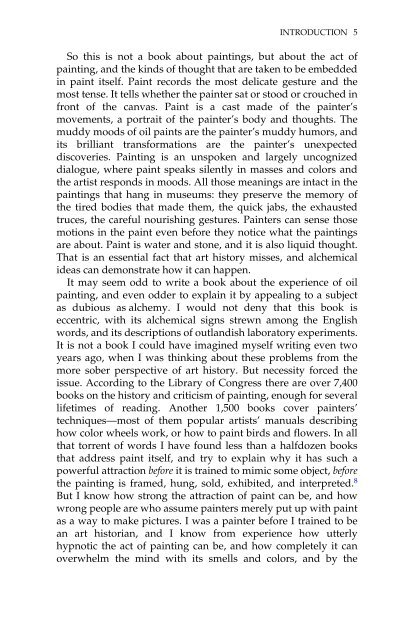What Painting Is: How to Think about Oil Painting ... - Victoria Vesna
What Painting Is: How to Think about Oil Painting ... - Victoria Vesna
What Painting Is: How to Think about Oil Painting ... - Victoria Vesna
Create successful ePaper yourself
Turn your PDF publications into a flip-book with our unique Google optimized e-Paper software.
INTRODUCTION 5<br />
So this is not a book <strong>about</strong> paintings, but <strong>about</strong> the act of<br />
painting, and the kinds of thought that are taken <strong>to</strong> be embedded<br />
in paint itself. Paint records the most delicate gesture and the<br />
most tense. It tells whether the painter sat or s<strong>to</strong>od or crouched in<br />
front of the canvas. Paint is a cast made of the painter’s<br />
movements, a portrait of the painter’s body and thoughts. The<br />
muddy moods of oil paints are the painter’s muddy humors, and<br />
its brilliant transformations are the painter’s unexpected<br />
discoveries. <strong>Painting</strong> is an unspoken and largely uncognized<br />
dialogue, where paint speaks silently in masses and colors and<br />
the artist responds in moods. All those meanings are intact in the<br />
paintings that hang in museums: they preserve the memory of<br />
the tired bodies that made them, the quick jabs, the exhausted<br />
truces, the careful nourishing gestures. Painters can sense those<br />
motions in the paint even before they notice what the paintings<br />
are <strong>about</strong>. Paint is water and s<strong>to</strong>ne, and it is also liquid thought.<br />
That is an essential fact that art his<strong>to</strong>ry misses, and alchemical<br />
ideas can demonstrate how it can happen.<br />
It may seem odd <strong>to</strong> write a book <strong>about</strong> the experience of oil<br />
painting, and even odder <strong>to</strong> explain it by appealing <strong>to</strong> a subject<br />
as dubious as alchemy. I would not deny that this book is<br />
eccentric, with its alchemical signs strewn among the English<br />
words, and its descriptions of outlandish labora<strong>to</strong>ry experiments.<br />
It is not a book I could have imagined myself writing even two<br />
years ago, when I was thinking <strong>about</strong> these problems from the<br />
more sober perspective of art his<strong>to</strong>ry. But necessity forced the<br />
issue. According <strong>to</strong> the Library of Congress there are over 7,400<br />
books on the his<strong>to</strong>ry and criticism of painting, enough for several<br />
lifetimes of reading. Another 1,500 books cover painters’<br />
techniques—most of them popular artists’ manuals describing<br />
how color wheels work, or how <strong>to</strong> paint birds and flowers. In all<br />
that <strong>to</strong>rrent of words I have found less than a halfdozen books<br />
that address paint itself, and try <strong>to</strong> explain why it has such a<br />
powerful attraction before it is trained <strong>to</strong> mimic some object, before<br />
the painting is framed, hung, sold, exhibited, and interpreted. 8<br />
But I know how strong the attraction of paint can be, and how<br />
wrong people are who assume painters merely put up with paint<br />
as a way <strong>to</strong> make pictures. I was a painter before I trained <strong>to</strong> be<br />
an art his<strong>to</strong>rian, and I know from experience how utterly<br />
hypnotic the act of painting can be, and how completely it can<br />
overwhelm the mind with its smells and colors, and by the


